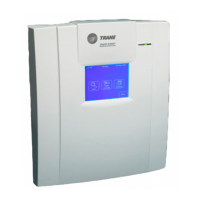Chapter 4 UCM Communication-Link Wiring
64 BMTW-SVN01F-EN
Recommended Wiring Practices
The following guidelines should be followed while installing communica-
tion wire:
• Although Comm5 does not require polarity sensitivity, Trane recom-
mends that the installer keep polarity consistent throughout the site.
• Only strip away 2 inches maximum of the outer conductor of shielded
cable.
• Make sure that the 24 Vac power supplies are consistent in how they
are grounded. Avoid sharing 24 Vac between Comm5 UCMs.
• Avoid overtightening cable ties and other forms of cable wraps. This
can damage the wires inside the cable.
• Do not run Comm5 cable alongside or in the same conduit as 24 Vac
power. This includes the conductors running from triac-type inputs.
• In an open plenum, avoid lighting ballasts, especially those using
277 Vac.
• Use a daisy chain configuration. Branch configurations are not rec-
ommended.
Fiber-Optic UCM Communication
Fiber-optic cable is used for applications involving long distances because
there is little degradation of optic signals, and the integrity of the signal
is maintained in the presence of several sources of electrical noise, includ-
ing lightning, EMI/RFI, voltage conductors, and ground loops.
Trane requires duplex, 62.5 µm core glass fiber-optic cable with ST con-
nectors. There are a variety of cables available for different applications
including indoor, outdoor, burial, aerial, and duct.
You can order fiber-optic cables, fiber-optic modems, ST-type crimp con-
nectors, epoxy connectors, and other accessories from Trane through the
Buying Group.
Typically, the fiber-optic UCM communication link is used in applications
where a BCU located in one building communicates not only to the UCMs
within that building, but also to other UCMs located in other buildings.
The fiber-optic cable is used typically as the communication link between
buildings, and it uses EIA-485 data transceivers (D1300) and EIA-485
data repeaters (D2300), which are called fiber-optic modems. These
modems convert the electrical signals from a twisted pair of wires to opti-
cal signals, which are sent over the fiber-optic cable. At the other end, the
optical signals are converted back to electrical signals and sent along the
twisted pair of wires.
IMPORTANT
Trane recommends that only qualified and experienced fiber-optic tech-
nicians prepare the fiber-optic end connectors and cable run lengths.
Improper methods may result in faulty communication due to signal

